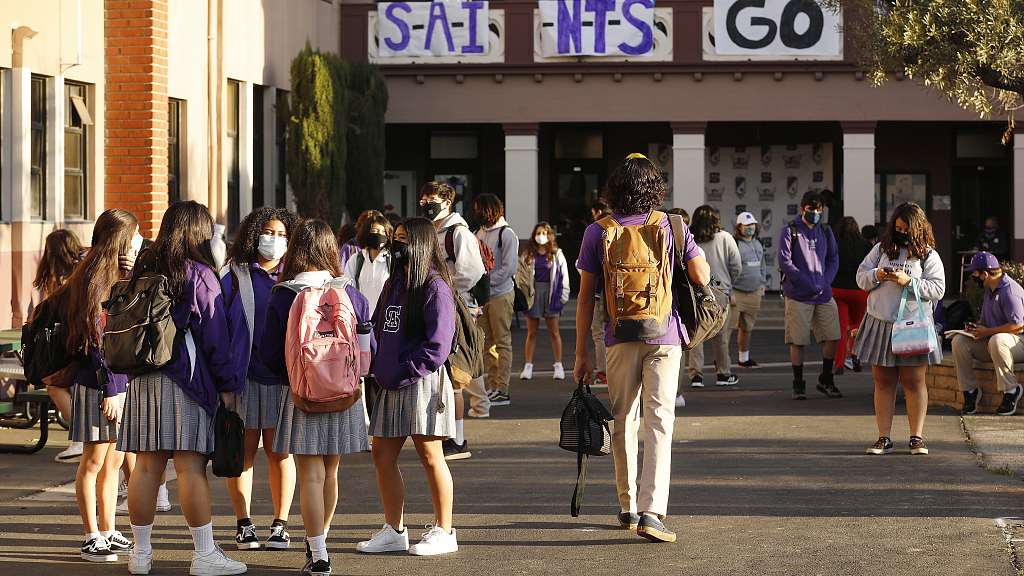
Students chat outside a building at St. Anthony Catholic High School in Long Beach, California, United States, March 24, 2021. /CFP
Students chat outside a building at St. Anthony Catholic High School in Long Beach, California, United States, March 24, 2021. /CFP
Editor's note: Thomas O. Falk is a London-based political analyst and commentator. He holds a Master of Arts in international relations from the University of Birmingham and specializes in U.S. affairs. The article reflects the author's opinions and not necessarily the views of CGTN.
The statistics on mental health in America have been staggering and saddening for a while. One in five Americans experiences some form of mental illness, with anxiety and depression being the most common. Suicide rates have been rising for the past decade, with more than 48,000 people dying by suicide in 2021.
Thus far, many of the most influential policymakers in the U.S. have been unwilling to initiate relevant changes – the following data from the Center for Disease Control and Prevention (CDC) is a testament to that, as the findings reflect decades of neglect of mental health that is now increasingly impacting teenagers.
And the CDC biannual Youth Risk Behavior Survey, considered the gold standard of teenage mental health in America, offers a painful and, for parents, scary glance at a new reality.
It concludes that nearly three in five teen girls (57 percent) felt "persistently sad or hopeless"– twice as many as young boys, the highest mark in a decade. 30 percent of teen girls stated they have seriously considered suicide, which is an increase of nearly 60 percent over the past decade.
These findings paint a disturbing picture of American youth in a state of emotional catastrophe and arguably mark the most shocking findings in three decades of collected data.
What makes these findings particularly striking and strange is the context they occur in.
America, despite its issues, remains a vastly wealthy nation. Unemployment has been the lowest since the 1960s, and the country's poverty rate is the lowest on record while America's youth grows up in peacetime.
It is thus not a situation where one can easily point to some material condition in the U.S. Teens are not concerned about their parent's job security or where their next meal is coming from. The reality simply does not support such an argument.
But it gets even stranger when one looks at teenage behavior. Bullying, for instance, is not increasing. Teens are smoking and drinking less and consuming fewer drugs.
All of these stats, in correlation with the survey, present America with a mystery: Why is teen anxiety rising exponentially when all the subjects that are the usual suspect can be ruled out?

Young people gather on Dolores Street and 20th Street on Halloween night in San Francisco, California, United States, October 31, 2022. /CFP
Young people gather on Dolores Street and 20th Street on Halloween night in San Francisco, California, United States, October 31, 2022. /CFP
The data also shows that mental health problems have increased since 2011 – and thus, predates the pandemic. While there's been an uptick, it seems too easy and scientifically unsound to entirely blame two years of isolation for the current status quo.
So, what exactly is the cause of this staggering increase in mental health issues? Mobile phones and social media are often used as culprits. However, the available research on this remains rather suboptimal.
But lacking knowledge of the cause doesn't mean that steps cannot be taken to mitigate these struggles.
After all, the risks associated with the CDC's findings are apparent: Poor mental health can impede a teen's ability to focus in school and have normal friendships. Moreover, self-harm becomes a real possibility. It is thus crucial to identify an issue and intervene early before it affects their adulthood.
However, on a macro level, this is easier said than done, given that America's healthcare system is simply not designed for its current crisis nor to answer the questions many parents will now have.
All of it starts with the utter lack of awareness in the U.S. Nearly a quarter of Americans still don't consider mental health on par with other health encumbrances. Without awareness, mental health will remain an area within the health industry that is chronically underfunded. For instance, America ranks 29th out of 38 nations that are part of the Organization for Economic Cooperation and Development when it comes to the number of beds available for psychiatric hospitalization – and notoriously underreported.
Access remains the second significant challenge in general, but specifically when facing mental health issues. High costs, a shortage of mental health professionals, and stigma are all factors that make it difficult for people to get the help they require.
But let's face it, the issues outlined in the CDC's survey cannot be solved by hiring more guidance counsellors. They will require cultural shifts – and a sustained effort and commitment from various stakeholders, including policymakers, healthcare providers, educators, parents, and communities.
The U.S. must invest in mental health services, create a public discourse around it, and ensure everyone can access the care they need. This means providing funding for mental health research and treatment, expanding access to telehealth services, and honestly addressing the root causes of mental illness, such as poverty, trauma, and systemic racism.
Because what we do know is the following: The Young Risk Behavior Survey is far more than a collection of empirical data.
It is a cry for help from American teenagers that has fallen on deaf ears thus far.
However, the fact that a national conversation on this emergency doesn't even exist yet makes one rightfully wonder whether or not help is coming.
Do better, America.
(If you want to contribute and have specific expertise, please contact us at opinions@cgtn.com. Follow @thouse_opinions on Twitter to discover the latest commentaries in the CGTN Opinion Section.)